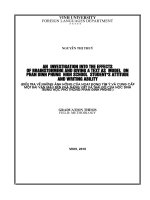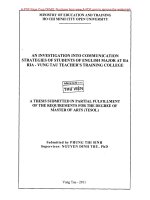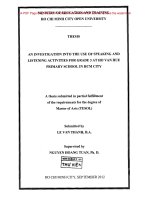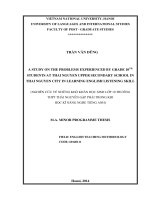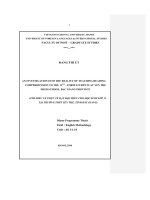An investigation into writing strategies of 11th grade students at Huu Lung upper secondary school, Lang Son
Bạn đang xem bản rút gọn của tài liệu. Xem và tải ngay bản đầy đủ của tài liệu tại đây (483.08 KB, 68 trang )
VIETNAM NATIONAL UNIVERSITY, HANOI
UNIVERSITY OF LANGUAGES & INTERNATIONAL STUDIES
FACULTY OF POST- GRADUATE STUDIES
LÊ THỊ HỒNG VINH
AN INVESTIGATION INTO WRITING STRATEGIES OF 11th
GRADE STUDENTS AT HUU LUNG UPPER SECONDARY
SCHOOL, LANG SON.
(Nghiên cứu về chiến lược học viết tiếng Anh của học sinh lớp 11
trường Trung Học Phổ Thông Hữu Lũng- Lạng Sơn)
MA. MINOR PROGRAMME THESIS
Field: English Teaching Methodology
Code: 60.14.0111
Hanoi, 2014
VIETNAM NATIONAL UNIVERSITY, HANOI
UNIVERSITY OF LANGUAGES & INTERNATIONAL STUDIES
FACULTY OF POST- GRADUATE STUDIES
LÊ THỊ HỒNG VINH
AN INVESTIGATION INTO WRITING STRATEGIES OF 11th
GRADE STUDENTS AT HUU LUNG UPPER SECONDARY
SCHOOL, LANG SON.
(Nghiên cứu về chiến lược học viết tiếng Anh của học sinh lớp 11
trường Trung Học Phổ Thông Hữu Lũng- Lạng Sơn)
MA. MINOR PROGRAMME THESIS
Field:
English Teaching Methodology
Code:
60.14.0111
Supervisor: Trần Thị Thu Hiền, Ph.D
Hanoi, 2014
DECLARATION
I hereby certify the thesis entitled “An Investigation into writing strategies of 11th
grade students at Huu Lung Upper Secondary School, Lang Son” is my own
study in the fulfillment of the requirements for the Degree of Master of Arts at
University of Languages and International Studies, Vietnam National University,
Hanoi.
Hanoi, September 2014
Signature
Le Thi Hong Vinh
i
ACKNOWLEDGEMENTS
On the completion of this thesis, I wish to express my heartfelt gratitude and deep
gratitude to my supervisor, Tran Thi Thu Hien, PhD, who gave me benefits of her
wisdom and her expert knowledge in teaching methods as well as her constant
encouragement from the beginning stage of working out the research proposal to the
final stage of writing up the thesis for her. Without her valuable suggestions, careful
and detailed critical comments, this thesis would not have been fulfilled.
My sincere thanks also go to all my grade-11 students and teachers at Huu Lung
Upper Secondary School for their assistance during the process of data collection.
Also, my appreciation goes to my family and friends for their support whose
encouragement and assistance are of extreme importance during the course of my
writing.
ii
ABSTRACT
The present study aimed at exploring writing strategies employed by the eleventh
graders at Huu Lung Upper Secondary School (HLUSS). Participants were eighty
eleventh graders identified as successful and unsuccessful writers. The data for the
study was gathered utilizing questionnaire and interview. Oxford’s theory (1990)
and Petric Czarl’s writing strategy questionnaire (2003) were used to formulate
students’ writing strategies. The data was analyzed using descriptive statistics and
SPSS 16.0 software.
The findings of this study revealed that twelve writing strategies were used at the
highest degree by eleventh graders at HLUSS in which while-writing ones were
most frequently employed. Despite no variation in the frequency of the overall
writing strategy use between two parties of writers, several differences were found
in the use of individual items. Some implications and suggestions for learning and
teaching writing strategies were offered to enhance students’ writing performance.
iii
LIST OF TABLES
Page
Tables
Table 1 Writing strategy use in each stage by students in the writing
class................................................................................................ 24
Table 2
Overall writing strategies most frequently used...........................
25
Table 3 Mean and standard deviation of overall writing strategy between
successful and unsuccessful students.............................................
Table 4 Mean and standard deviation of writing strategy at different
27
27
stages ............................................................................................
Table 5
between successful and unsuccessful students
Mean and standard deviation of prewriting strategies used by ..... 28
Table 6 successful and unsuccessful students Mean and standard
deviation of while-writing strategies used by .............................
Table 7
29
successful and unsuccessful students Mean and standard
deviation of revising strategies used by unsuccessful and
unsuccessful students..................................................................... 31
iv
LIST OF ABBREVIATIONS
EFL: English as a foreign language
ESL: English as a second language
HLUSS: Huu Lung Upper Secondary School
LLSs: language learning strategies
SD: Standard deviations
SPSS: Statistical Package for the Social Science
WSQ: Writing Strategy Questionnaire
v
TABLE OF CONTENT
Declaration...................................................................................................................i
Acknowledgements………………………………………………………….............ii
Abstract ………………………………………………………………………….....iii
List of table …………………………………………………………………...….....iv
List of abbreviations……………………………………………………………........v
Table content ……………………………………………………………………….vi
PART A: Introduction……………………………………………………………..1
1. Rationale……………………………………………………………….……..1
2. Aims of the study .…………………………………………………………...2
3. Research question….………………………………………………………....2
4. Method of the study……..……………………………………………….…...2
5. Scope of the study…………………………………………………………….3
6. Significance of the study..……………………………………………………3
7. Organizations of the study ……………………………………………….......3
PART B: DEVELOPMENT ……………………………………………………...5
Chapter 1. Literature Review.…..………………………………………………..5
1.1 Learning language strategies ……………………………………………….5
1.1.1 Definition of learning language strategies………………………..........5
1.1.2. Classification of learning language strategies………………………....6
1.2. Writing strategies…………………………………………………………...9
1.2.1. Definition of writing strategy……………………………………….....9
1.2.2. Writing strategy questionnaire…………………………………………9
1.3. Writing approaches………………………………………………………...10
1.3.1. Product approach……………………………………………………..11
1.3.2. Process approach……………………………………………………...12
1.4. Previous studies …………………………………………………………...13
1.4.1. Previous studies on language learning strategies……………………13
vi
1.4.2. Previous studies on writing strategies………………………………14
1.5.Summary……………………………………………………………………16
Chapter 2. Methods………………………………………………………………18
2.1. Setting of the study………………………………………………………...18
2.2. Participants…………………………………………………………………19
2.2.1. Students………………………………………………………………..19
2.2.2. Teachers……………………………………………………………….19
2.3 Instruments ………………………………………………………………...19
2.3.1.Questionnaire…………………….……………………………………19
2.3.2. Interview……………………………………………………………...20
2.4. Data collection procedure ………………………………………………...21
2.4.1. Questionnaire………………………………………………………….21
2.4.2. Interview………………………………………………………………22
2.5. Data analysis……………………………………………………………….22
2.6 .Summary…………………………………………………………………..23
Chapter 3: Results and Discussion………………………………………………24
3.1.Results ………………………………………………………………………24
3.1.1.Questionnaire…………………………………………………………...24
3.1.1.1.Writing strategies most frequently used by 11th HL students……24
3.1.1.2. Differences in writing strategy use based on proficiency level…26
3.1.2. Interview………………………………………………………………..31
3.2. Findings and discussions…………………………………………………....32
3. 3. Chapter summary …………………………………………………………..34
PART C: Conclusion……………………………………………………………..35
1. Recapitulation …………….. ………………………………………………...35
2. Implications…………………………………………………………………..35
3. Limitations of the study and suggestion further studies……………………..37
REFERENCES…………………………………………………………………....39
Appendix 1
……………………………………………………………………….I
vii
Appendix 2 ……………………………………………………………………….III
Appendix 3 ………………………………………………………………………...V
Appendix 4 ……………………………………………………………………....XIV
viii
PART A: INTRODUCTION
1. Rationale of the study
The crucial role of writing cannot be denied in the language learning process.
According to Harmer (2007:112), this productive skill is a practical tool to give
learners chances for language utilization they have been studying. Paradoxically,
writing is an extremely difficult skill and poses great challenges for many second or
foreign language learners to truly grasp. Because writing is “not an innate skill or
potential aptitude, but as a developmental capacity” (Grabe and Kaplan, 1996:151),
and a highly complicated process requiring writers to uncover thoughts and ideas,
making them concrete and individual (Matsuda, 2003; Westwood, 2004) or a
process in which an initial idea in writing task needs refining and expanding by
learners (Shaughnessy,1977: 234).
However, in approaching writing tasks such as writing a paragraph, a description, a
narrative or a letter, students at Huu Lung Upper Secondary School (HLUSS),
especially many eleventh graders seem to be more prone to finding solutions to
grammar and vocabulary problems, imitating or copying fixed organizational
patterns passively and unsuitably rather than analyzing or developing ideas. As a
result, they fail to attain writing skills which lead to the burnout and low marks in
writing.
There goes an old Chinese proverb that “Teachers open doors, but you must enter
by yourself”. When applied to the language teaching and learning, this proverb
probably means that teachers should provide their learners with good opportunities
to acquire knowledge and the learners should know how to take the initiative to
apply that knowledge to their own case to be able to be more successful.
Nevertheless, most of the learners little apply and sometimes ignore appropriate
writing strategies when they take guidance from their teachers. As Wenden and
Rubin (1987) found out that some learners were more successful than others since
they used learning strategies more effectively. Furthermore, Oxford (1990:1) claims
1
that the application of the appropriate learning strategies can lead to improved
proficiency and greater self-confidence. This suggests that arousing learners’
awareness of strategy use in learning can improve the learners’ result.
Writing strategies have been identified by various researchers in both second and
foreign language contexts ( Petric & Czarl 2003; Pham Thu Hien, 2004; Chen ,
2011, Maarof & Murat, 2013) . Yet, there has not been any practical strategy study
conducted to uncover and clarify what strategies HLUSS students actually use in
writing.
For all the reasons above, the researcher would like to investigate the use of writing
strategies of 11th grade students at HLUSS with the hope to reformulate the writing
strategies used by the group, namely “successful writers”, then, apply them to train
“unsuccessful writers” to help improve their writing skill.
2. Aims of the study
Research hopes to find ways to help students learn to write in English better.
Specifically, it aimed to find out what writing strategies are used most frequently by
the eleventh graders at HLUSS in their writing tasks in English and to determine
whether there were any differences in writing strategies used between successful
and unsuccessful students.
3. Research questions
The current study attempts to address the following research questions:
1.
What writing strategies are most frequently used by eleventh graders
at Huu Lung Upper Secondary School?
2.
Are there any differences in the use of writing strategies between
successful and unsuccessful students?
2
4. Method of the study
To achieve the objectives of the research, the study was conducted by using
questionnaire and interview. The questionnaire was used as the major instrument of
data collection and interview was employed to confirm more reliable data from the
survey questionnaire. In addition, SPSS software was employed to analyze the data
collected from the survey.
5. Scope of the study
Concerning the scope of the study, the following issues should be taken into
consideration. First, the study relates to writing strategies used by the eleventh
graders at HLUSS, Lang Son Province. Second, writing strategies are studied in
various writing tasks such as writing a paragraph, a description, a narrative or a
letter.
6. Significance of the study
The current study is significant for several following reasons. First, it makes a
significant contribution to investigate the writing strategy use of eleventh graders at
HLUSS. Second, it clarifies how writing strategies are applied. Finally, many
important implications are discussed not only to arouse learners’ awareness of the
use of writing tactics and help learners use their writing strategies as effective
language learning tools but also to help teachers make sense of their students’
strategy use and share strategies with other learners or ponder their teachers’ future
teaching direction in writing.
7. Organization of the study
This thesis consists of three parts, namely introduction, development and
conclusion.
3
Part A is introduction which provides an overview of the study including the
rationale, the aims, methods, the scope, the significance and the design of the study.
Part B, Development, has three distinguishable chapters.
Chapter 1, Literature Review, reviews theoretical background on which the whole
study is based concluding terminological definitions and taxonomies of language
learning strategies, writing strategy and approaches to teaching writing.
Chapter 2, Methodology, briefly presents the methodological framework of the
study. It covers features of the participants, setting of the study, instruments and
data collection procedure.
Chapter 3, findings and discussion, presents findings and discusses the findings,
which gives comprehensive answers to the two research questions.
Part C, Conclusion, summarizes significant findings, suggest implications for
writing strategy instructions at HLUSS, addresses notable limitations, and puts
forward practical suggestions for future research.
4
PART B: DEVELOPMENT
CHAPTER 1: LITERATURE REVIEW
This chapter discusses the theory and research into the five areas that form the
underpinnings for this study. The first section begins with an overview of
theoretical issues on terminological definitions and classification systems of
language learning strategies. The second section puts forward writing strategies, and
writing strategy questionnaire. The third section provides writing approaches in
teaching writing. The fourth section concludes a review of previous studies on LLSs
and writing strategies. Finally, the main points are summarized at the end of this
chapter
1.1. Language learning strategies
This section puts forward relevant issues of language learning strategies (LLSs) in
terms of definition and classification
1.1.1. Definition of language learning strategies
There are various definitions on language learning strategies given by various
researchers and scholars, but this thesis only focuses on definitions by Rubin
(1975), Tarone (1983), and Oxford (1990).
Learning strategies are, as Rubin (1975:43) defined, “the techniques or devices
which a learner may use to acquire knowledge”.
Tarone (1983) defines a learning strategy as an effort to “develop linguistic and
sociolinguistic competence in the target language - to incorporate these into one's
interlanguage competence" (cited in O'Malley and Chamot, 1990:47).
Language learning strategies are, as Oxford (1990:8) defined , “specific actions
taken by the learner to make learning easier, faster, more enjoyable, more selfdirected, more effective, and more transferable to new situations” .
5
These strategies seem to share the same characteristics: LLSs are “what students do
to assist their learning” (Bremner, 1999:8).Obviously, researchers use these
different terms to depict strategies and to explain for their own targets (Bremner,
1999:8).
Griffiths (2004:2) states that Rubin is one of the pioneers in the realm of doing
research of learning strategies, Rubin’s definition, hence, is too broad to cover.
In Tarone’s definition, although it may contribute to the language learning process
to a certain extent, learner autonomy, cultural understanding, or other aspects of
language learning are not underlined (Lan, 2005:16).
Compared with other definitions, Oxford’s is considered to be one of the most
comprehensive ones (Lan, 2005:15). Furthermore, her definition adds affective
factor used for other purposes like making learners more enjoyable which is not
reflected in other definitions (Alhaisoni, 2012:116).
For the purpose of the study, Oxford’s definition acts as a guideline for the present
research because of its clearness, concrete and easy comprehension.
1.1.2. Classification of language learning strategies
There are several different viewpoints on the classifications of LLSs in the field of
second and foreign language learning. To seek a suitable classification of LLSs for
this study, the most common classifications of LLSs proposed by Naiman et al.,
(1978), Rubin (1981), and Oxford (1990) are presented in this study.
First, Naiman et al., (1978) presented a classification including five major strategies
such as (i) an active task approach, (ii) realization of language as a system, (iii)
realization of language as a means of communication and interaction, (iv)
management of affective demands, and (v) monitoring of second language
performance. He emphasizes on distinctive learning strategies of good language
6
learners with expectation of transferring the strategies used by the good language
learners to the poor ones. However, Gass & Selinker (2008:443) point that, “…
studies which do not include poor learners cannot be used to say that poor learners
do the same thing that so-called good learners do”. This classification, thus, is
irrelevant to the current study aiming at exploring the LLSs use in writing of both
“successful” and ‘unsuccessful” writers.
Rubin (1981) classifies LLSs into two broad categories with eight sets such as (i)
clarification/verification, (ii) monitoring, (iii) memorization, (iv) guessing/inductive
reasoning, (v) deductive reasoning, and (vi) practice. A distinctive point in the
classification proposed by Rubin is its direct influence to learning (O’Malley and
Chamot, 1990: 3). Additionally, it makes “a sketch of important strategies” utilized
by successful language learners. (Lan , 2005) : 21). Her category, however, makes
up of certain limitations. As pointed by Gass & Selinker (2008:443) above, the
model only basing on her observations of the good language learners does not
correlate to the study which tend to explore both successful learners and
unsuccessful ones.
A common limitation in the classification by both Rubin and Naiman et al is that the
theoretical foundation of second language acquisition or cognition is ignored which
results in difficulty to identify the foundation for learning (O’Malley and Chamot,
1990: 7).
Although the taxonomies above yield some first insights for language learning
strategies, the visible weaknesses of the classification emerge which seem to be
unsuitable for the current study. The study, thus, needs to work out more
appropriate classification. This is followed by another specific classification
introduced by Oxford (1990).
Taxonomy proposed by Oxford (1990:37) divides the language learning strategies
into two major classes, direct and indirect with 62 question items. Each class is
7
composed of three groups: memory, cognitive and compensation under the direct
class; metacognitive, affective, and social under the indirect one
The first classification is direct strategies that directly refer to the purpose of
language. Its three subcategories are memory strategies for language learners to
store and retrieve new information needed for communication; cognitive strategies
for learners to make out and produce new language by numerous different means
easier and compensation strategies for assisting learners to get over their knowledge
limitations in language use.
The second taxonomy of strategy class is indirect learning strategies that “supports
and manages language learning without directly involving the target language”
with three groups: metacognitive strategies, affective strategies and social strategies
(Oxford, 1990:135). First, metacognitive strategies are actions which provide a way
for learners to cooperate their own learning process. Second, affective strategies are
actions that assist learners regulate their motivation, attitude, as well as significantly
influence their learning success or failure. The third ones, social strategies “help
students learn through interaction with each other”. Oxford (1990) emphasizes that
indirect strategies are useful and able to apply for the development of all language
skills.
By and large, compared with other categories, Oxford (1990) brings about an
exclusive taxonomy (Ghee et al, 2010:51) and her classification is appreciated to be
the most comprehensive one of learning strategies to date (Ellis, 1994:539).
Particularly, Oxford (1990) hints two additional kinds of strategies in detail such as
compensatory strategies, memory strategies that are not included in previous
categories and depicts social and affective strategies as distinct. This new point is
said to be “part of language learner self-regulation” (Oxford, 2003:112).
Moreover, in view of Oxford (1990:37), she asserts that the six strategy categories
support mutually for the purpose of assisting learners to get more achievement in
8
their own learning and these strategies with 62 question items can be applied to 4
language skills with some changes for appropriateness of each.
Basing on Oxford’s classification of LLSs, some suggestions for modifications were
offered to be more suitable to explore learners’ writing strategies. The next section
will present the issues related to writing strategies
1.2. Writing strategies.
This section represents writing strategies including definitions and the writing
strategy questionnaire
1.2.1. Definition
Writing strategies are defined by Petric and Czarl (2003:189) as “actions or
behaviours consciously carried out by writers in order to make their writing more
efficient”. Another definition by Lei (2008:220) of writing strategies is “mediated
actions which are consciously taken to facilitate writers’ practices in communities”.
According to Petric and Czarl (2003:190), the definition of writing strategies
concentrates on students’ perceptions of the writing strategy use, which may not be
the same as the actual strategies applied.
In analyzing writing strategies, linguists proposed some different writing strategy
questionnaires.
From
different
perspectives,
different
writing
strategy
questionnaires can be used or adapted. Writing strategy questionnaire will be
presented in the next section.
1.2.2. Writing strategy questionnaire
Basing on Oxford’s format of Strategy Inventory for Language Learning, Petric and
Czarl (2003) made some suggestions for changes of questionnaires so that it can be
appropriate for investigation into writing strategies. The authors divided it into three
subcategories: (i) planning strategies (8 items), (ii) while-writing strategies (14
9
items), and (iii) revising strategies (16 items) (see Appendix 3). They emphasized
that this division was introduced for the sake of clarity. According to Jackson
(2006: 154) these items had a strong reliability.
To construct its reliability and validity, the authors conducted studies with different
groups of members of the target population, i.e., advanced non-native speakers of
English, in academic environments.
To establish the reliability of data collection instruments applicable to
questionnaires, Petric and Czarl (2003) undertook a study among English majors at
a Hungarian university by using the test–retest as the main reliability check method
proposed by many researchers (e.g. Seliger and Shohamy, 1989; Alderson and
Banerjee, 1996; Hatch and Lazaraton, 1991). According to Petric and Czarl
(2003:191), this method has been proved to be stable over time and relatively
feasible to be applied in regular school settings.
To build its validity, the authors applied the think- aloud protocol termed by
Converse and Presser (1986) and interview by Alderson and Banerjee (1996). The
results revealed that relevant types of validity are considered to be content,
construct and response validity. Moreover, validation using triangulation of
different data sources provides “not only information on the validity of the
instrument but also valuable insights into the construct itself.” (Petric and Czarl
2003:191)
From all the reasons above, the present research bases on definition of LLSs, some
theories of proposed by Oxford (1990) and writing strategy questionnaire by Petric
and Czarl (2003) which act as the key direction to its investigation because of their
clearness, concreteness and validity. The following section will discuss writing
approaches.
1.3. Writing approaches
10
There are a number of different approaches toward teaching writing emerging over
the years, each of which has its distinctive focuses leading to the use of different
strategies to help ESL/ EFL learners fulfill their writing tasks. To some extent, the
approach to teaching writing affects the investigation into writing strategies. In this
study, two approaches will be presented, namely product approach and process one
for the purpose to identify the one that is better in teaching writing.
1.3.1. Product approach
This approach is, as Nunan (1991: 86) states, “consistent with sentence - level
structuralist linguistics and bottom – up process”. According to Pincas (1982: 22),
the product approach includes four stages: familiarization, controlled writing,
guided writing and free writing. The purpose of familiarization stage is to arouse
learners’ awareness of certain features of a particular text. In the controlled and
guided writing sections, the learners’ practice in skills aims at increasing freedom
until they are ready for the free writing section, when they “use the writing skill as
part of a genuine activity such as a letter, story or essay”
This approach has some merits. As stated by Nunan (1991: 87), the focus on usage,
structure, or correct form would result in the improvement of writing. Moreover,
Likewise, Rodrigues (1985) and Howowitz (1986) (cited in Nunan 1991: 87)
advocate that overall goal of the product approach to teaching writing is to develop
the learner’s ability to the creation of grammatically accurate texts that will be
encountered in academic or personal setting.
Nevertheless, the limitations of the product-oriented approach to the teaching
writing have been pointed out by other researchers. First, it mainly focuses on the
end result of learning process in which learners attempt to imitate, copy and
transform fixed organizational models of correct language at the level of the
sentences provided by the teachers or textbook to facilitate the meaning of the
sentences (Nunan, 1991:86-87). Thus, it is said that less attention is paid to purpose,
11
communication, audience, or the process of composition ( Zamel ,1982:195) ,
there is “ no freedom to make mistakes” (Pincas,1982:91) or “little or no
opportunity for learners adding any thoughts or ideas of their own” (Raimes 1983:
10). Also, Hamer (1991: 257) and Nunan (1990:8) add that the product approach
primarily concerns the aim of a task and the end product. And it is supposed to be
more suitable to some kinds of text such as formal letters or postcards (Steele,
2005).
1.3.2. Process approach
Later, the emergence of the process approach in teaching writing has drawn
attention to various language researchers. According to Zamel (1982: 196), the
process approach makes up of the act of writing, pre - writing and re-writing and is
said to beneficial to students with the various classroom activities. Raims (1983:10)
depicts that in the process approach, “students do not write on a given topic in a
restricted time and hand in the composition . . . rather, they explore a topic through
writing” . Nunan (1991: 87) points out that thanks to this approach, learners can
work together as a way of increasing motivation and developing positive attitudes
toward writing. Supporting these views, While and Arndt (1991: 11) suggest a
process writing model involving six recursive procedures.
In this model, the first writers’ task is drafting to brainstorm ideas. Followed this is
structuring by ordering information, experimenting with arrangements, etc. Next
step is reviewing in which writes check context, connections, assess impact and
edit. The fourth stage, focusing, makes sure that the writer is getting the message
across she wants to get across. The fifth one, generating, writers have to generate
ideas. Finally, the writing needs evaluating.
Although, the process – oriented approach is said to take time to brainstorm ideas
(Hammer, 2001: 258), it is believed to promote the development of skilled language
and the responsibility and control of learning is shifted from teacher to students
12
(Nunan, 1991: 86-87). In other words, the teachers in the process-oriented writing
classes serve as facilitators who enable the learners to develop effective composing
strategies. Though there are views of strength of the composing process revealed by
process oriented studies, most writing classes are still based on mechanistic,
product- oriented exercises (Zamel, 1987: 701). This suggests that writing classes
may combine these two approaches. However, the research into the process of
composition makes contribution to raise implications for the methodology of
teaching writing in a second or foreign language.
1.4. Previous studies
This section will put forward an overview of previous studies in terms LLSs and
writing strategies in accordance with subject selection, data collection methods and
findings with the purpose of seeking the most suitable method for collecting data
then comparing the results of the study with those has been presented in this section.
1.4.1. Studies on language learning strategies
Alhaisoni (2012) conducted a significant research on the identification of the type
and frequency of the English language learning strategies of 701 male and female
Saudi EFL students at the University of Ha’il. The Oxford Strategies Inventory of
Language Learning was used with some modifications. The findings indicated that
highly proficient students used all six categories more than low-proficiency
students. The result revealed that the students utilized LLSs with low to medium
frequency. They preferred to use cognitive and metacognitive strategies the most,
used affective strategies and memory strategies the least.
Ismail and Khatib (2013) explored the patterns of language learning strategies
(LLS) used by 190 students in the Foundation Program of the United Arab Emirates
University (UAEU). It also investigated the effects of language proficiency level
and gender on the use of these strategies. The Oxford’s (1990) Strategy Inventory
for Language Learning was used for collecting the data. The results indicated that
13
these learners were overall medium strategy users. They utilized Metacognitive
strategies the most frequently used among the six strategies. Followed this was
social strategies, compensation strategies, affective strategies, cognitive strategies
and memory strategies respectively.
1.4.2. Studies on writing strategies
Pham Thu Hien (2004) investigated LLSs of Vietnamese EFL groups, namely
“effective” and “ineffective” writers in writing classes at a university in Vietnam.
Classroom observation, interview and questionnaire were served as data collection
instruments, and then data was analyzed by SPSS. The result showed that the
subjects utilized all of the direct and indirect strategies that were proposed by
Oxford (1990). Concretely, the effective writers used some strategies at higher
degree than the ineffective ones while they did writing tasks.
Chen (2011) conducted a present study aimed at investigating writing strategies
used by 135 Chinese non-English majors at Dezhou University. The questionnaire
proposed by Petric and Czarl, (2003) and interview were major means of collecting
date. The findings showed that in spite of using strategies in all stages of writing,
students tended to utilize
more writing strategies in while-writing
strategies
compared to pre-writing strategies and revising strategies; and writing strategies as
a whole have certain predictive power for writing achievements.
Another study undertaken by Maarof & Murat (2013) explored the writing strategy
use between two groups of high-intermediate and low proficiency ESL upper
secondary school students in Malaysia to determine any significant differences in
strategy use between them. The number of participant was 50. Data gathered by the
Writing Strategy Questionnaire by Petric & Czarl (2003) revealed that the whilewriting strategies were most frequently used by ESL students while the revising
strategies more were least used.
14
All the students displayed approximately similar frequency use of strategies but
differed only in the type of strategies used.
In summary, on the basis of a discussion on the previous studies, some comments
on subject selection, data collection method and results are given as follows:
In the first place, some generalizations can be made. First, the subjects chosen for
these studies are learners from different colleges studied by Pham Thu Hien (2004)
Alhaisoni (2012), Ismail and Khatib 2013 and Chen (2011) and high students in
Malaysian by Maarof & Murat (2013). These students learn English as a second or
foreign language. Second, most previous studies, the subjects are divided into
groups for comparison, namely successful learners and unsuccessful learners, highly
proficient and low proficiency students.
Second, in terms of methods, the classroom observation, interview and
questionnaire were adapted to investigate strategies. Nevertheless, no single
research method is perfect (Cohen and Scott, 1996) and how they are used depends
on the main purpose of the study (Robson, 2002:161).
Concretely, in the previous study by Pham Thi Thu Hien (2004), the observational
method failed to yield much strategy data. Because one of its key demerits is “its
inability to produce description of internal and mental strategies such as reasoning
or self – talk” or nothing about the mental operations learners use is revealed
(Cohen, 1998: 32). Additionally, little opportunity for learners to exercise behaviors
is produced (Ellis, 1994:532). Another weakness is that researchers probably collect
data only from the students who are more verbal and this may “limit the data to
only a subset of language learners- namely, the outspoken or extroverted” (Cohen,
1998:33). Thus, the observational method as stated is irrelevant to the current study.
Regarding interview, Cohen, et al., (2007:349) asserts that interview is a flexible
tool for data collection, allowing multi-sensory channels to be used: verbal, non-
15
